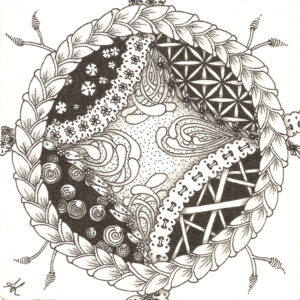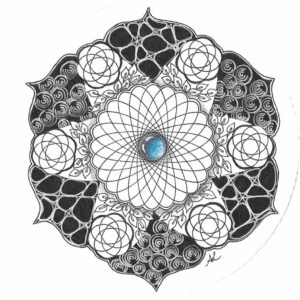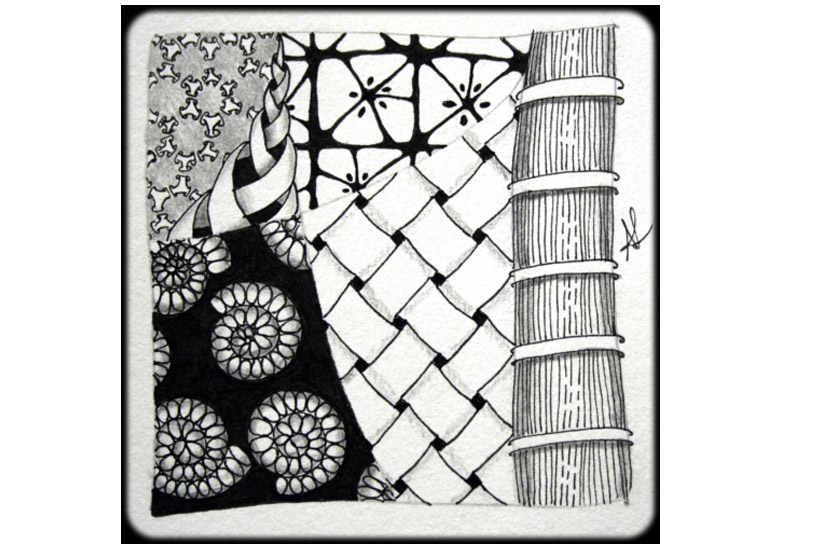Anya Lothrop sees more than beautiful images formed from repetitive patterns in Zentangle, a new art form. She sees a gateway for practitioners to reduce stress, increase well-being and enhance relaxation. Be forewarned. Lothrop is adamant that Zentangle Art not be confused with therapeutic techniques such as painting or collaging. It goes far beyond traditional art therapy according to, the author of Zentangle Art Therapy. She recently spoke withWellWell about the truth of Zentangle, its benefits and who can gain the most from it.
How does Zentangle work?
Zentangle works by drawing structured patterns we call tangles. These tangles are created through a combination of spontaneous and unforced dots, lines, and curves. The work is non-representational and unplanned. This means the artist gets focused on each individual stroke and does not stress about the end result.
What are the core benefits of learning Zentangle?
It’s a very calming and soothing sort of thing to do. It puts you in a meditative state where you can almost stop thinking at some point. Some people are able to sit down and meditate but it doesn’t work for everyone. I’ve found that for people unable to traditionally meditate, Zentangle often works quite well in reaching that state.
How does Zentangle help someone reach this state as opposed to traditional meditation?
 Since you’re focusing on the lines and the art, you automatically calm down and your thoughts slow down. It helps you to focus your attention to what you’re doing helping to relieve stress. I’ve actually heard several people who used it to get over sleeping disorders, nervousness, anxiety, and even depression. Some people say even their headaches went away after doing Zentangle.
Since you’re focusing on the lines and the art, you automatically calm down and your thoughts slow down. It helps you to focus your attention to what you’re doing helping to relieve stress. I’ve actually heard several people who used it to get over sleeping disorders, nervousness, anxiety, and even depression. Some people say even their headaches went away after doing Zentangle.
What do you think it is about Zentangle that would have this effect on depression and headaches?
My guess would be that any type of mediation would be beneficial. You’re not trying to mediate, you’re just automatically in a sort of meditative state. It helps center your mind and body, separating you from mundane troubles. I think that must be it.
Do you think Zentangle can be performed on a digital canvas, such as a tablet? Would the benefits remain?
The problem with that is the one thing Zentangle teaches you is that there are no mistakes. I have practiced on a tablet, however, it was primarily to practice my hand-eye coordination. What I found was I was frequently hitting command Z, to go back because I didn’t like the line I made and that’s not really what Zentangle’s about. You put a line and you leave it and if doesn’t look exactly the way you wanted it to look, it’s fine. If you do something that you would normally call a mistake, you go with it. Amazingly, people have even made up new patterns through so-called mistakes. They put a line somewhere else than where they wanted to and suddenly there’s a new pattern emerging and that’s possibly even more beautiful than they expected. If you do it digitally, you’d be very tempted to just go back.
Would you say this is a good pathway for people to learn other forms of art?
Absolutely, yes. It’s a great way to develop better hand-eye coordination. You learn to make more controlled lines and your lines go where you want them to after a while. I used to teach beginners classes we would do one Zentangle tile and by explaining a little bit and talking to people and it would take an hour and a half and after the hour and a half, everyone would have their finished Zentangle tile and usually what happens is people say, “Wow, I didn’t think I could draw like this. This is so beautiful. I didn’t expect to be this good.” You don’t stress so much because you’re not afraid to make mistakes because that’s kind of the point. It’s also very good as a warm-up exercise for artists. Because it gets you into that, I’m not so afraid, I’m not worried about what my mistakes might be sort of state of mind.

About Anya Lothrop
Anya Lothrop is a certified Zentangle Teacher and author of Zentangle Art Therapy. The book aims to encourage the reader to feel the flow, release their potential and explore this elegance in an empowering and uplifting way. The benefits of Zentangle Art Therapy include reduced stress, increased well-being and enhanced relaxation.












